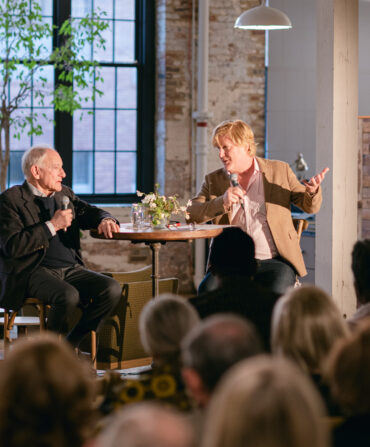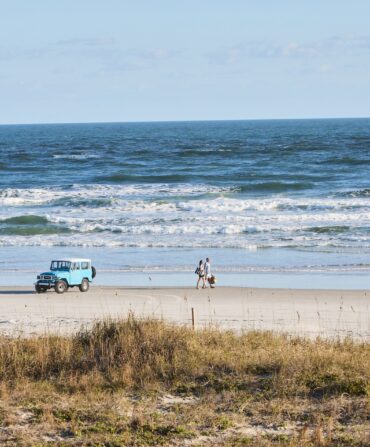Travel
John Brandon’s Florida Odyssey
A stranger-than-fiction road trip with the novelist and Sunshine State native John Brandon amid the swamps, springs, cemeteries, sinkholes, alligators, manatees, and real-life characters that inspired his epic Ivory Shoals

Photo: Cavin Brothers
The author (left) with novelist John Brandon and friend, dockside during a pit stop in Homosassa.
“Florida is a hot, wet, miserable human environment,” says the man with the rifle and the blue pantaloons.
Barely a day into our road trip across the Sunshine State, this does not come as news to me or John Brandon. We are standing in the sun at Ponce de Leon’s Fountain of Youth Archaeological Park, which is home to the fountain in question. Well, a fountain, anyway. Also, a scattering of re-created colonial and indigenous structures, a wedding venue, and a collection of peacocks that periodically let out screeches so hideous they invoke the tortured souls of men who made some terrible long-ago bargain to sip from the Fountain of Youth. John and I stand among a group of tourists as the man in the pantaloons demonstrates how to load his old-fashioned rifle. He wears red stockings, a vest, and a floppy hat, which we presume are authentic to the period, and speaks in a heavy Boston accent that we presume is not.
The aforementioned hot, wet misery wreaks hell on gunpowder, he explains, a condition that made the use of these firearms much more difficult than for colonists with the luck or foresight to do their colonizing in friendlier climes. He pours a measure of powder down the barrel, follows it with a wad of Spanish moss, and tamps it down.
“Fire in the hole!” he shouts. The gun goes off with a sharp clap. We all applaud.
“The next weapon demonstration takes place in fifteen minutes at the cannons,” the man says, sending us on our way. “Go Bruins.”
Afterward, we duck into a dim room containing a running spigot connected to an underground spring. There is a diorama of nearly naked Native Americans. We fill small plastic cups from the putative Fountain and sip. The water is warm and sulfury.
“I wonder if it makes you young again but smart,” John says. “Or young and dumb all over again.” The pamphlets sitting nearby offer no illumination. Outside, a peacock screams.
John Brandon and I are old friends, in strange times, on a somewhat absurd mission. Our aim is to follow in the footsteps of Gussie Dwyer, the twelve-year-old protagonist of John’s fourth and most recent novel, Ivory Shoals. Set in the immediate aftermath of the Civil War, the book falls somewhere between Treasure Island and Cormac McCarthy, shot through with John’s own sly humor and joy in language, and animated by a chorus of characters: fools, knaves, villains, and heroes. Gussie is very much in the last group. By the end of page two, Brandon has dispatched him on a classic Hero’s Journey: His beloved mother, a prostitute in a small town on the Atlantic coast, is dead. She has left behind little except for a gold watch that is Gussie’s only link to his father, who lives, unaware of his son’s existence, on a crumbling plantation on the Gulf of Mexico. So young Gussie, after robbing his mother’s boss, sets out to walk across the great peninsula, multiple perils ahead and a ruthless bounty hunter in pursuit behind.
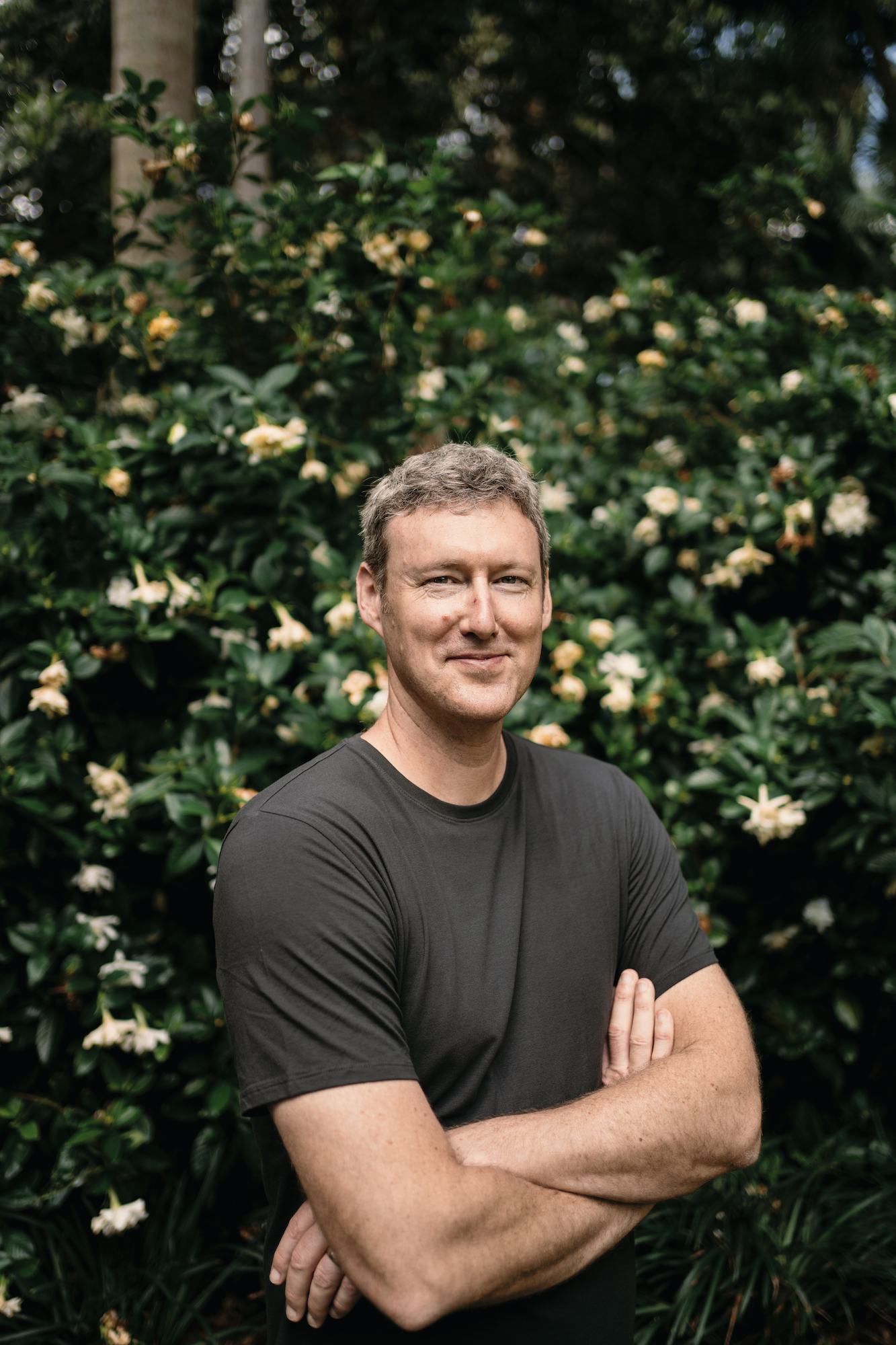
Photo: Cavin Brothers
Brandon, who grew up in New Port Richey.
It’s hardly the first time that John, who himself was born and raised near Tampa, has written about Florida. His debut may have been titled Arkansas, but even it took a detour into the Sunshine State. Still, Ivory Shoals is his most direct attempt yet to capture the place in all its strangeness, its oft-overlooked history, and its fearsome and beautiful natural landscape. At once a page-turner and a work with mythic resonance, it is a book he has talked about writing for as long as I have known him.
For weeks we have exchanged emails, plotting a route that roughly follows Gussie’s: from Jacksonville, down the coast to St. Augustine, west, in the direction of Gainesville, and then on to the Gulf to work our way down to St. Petersburg, near John’s parents’ home. For most of the trip we’ll be in a section of the state few picture when they hear Florida, let alone visit: south of the Panhandle, north of Disney, and so far from Miami, spiritually and geographically, that it might as well be another planet. We plan to stick to back roads, wandering wherever interest takes us, with an eye out for remnants of Gussie’s world.
“At some point, we’re going to have to find a sinkhole,” John wrote me, referring to one of Florida’s signature geological oddities, an example of which plays a dramatic role in Ivory Shoals.
Onto the list it goes: Sinkhole.
Our provisions, aside from the usual, include John’s heavily worn copy of the National Audubon Society Field Guide to Florida, the novel being, among many other things, a beautifully rendered, and seemingly exhaustive, catalogue of his home state’s abundant flora and fauna; a bottle of Calvados, of the sort sipped contemplatively by one of the book’s characters; and pipes and fresh tobacco, which Gussie smokes and shares with many of the picaresque characters he meets along the way. Neither of us is particularly looking forward to the pipe-smoking part, but a quest is a quest.
And what is ours? In addition to exploring the state’s mysterious middle, part of it is simply to move. I’ve been at home, in New Orleans, for the length of the pandemic, as John has been, outside the Twin Cities, where he teaches at Hamline University. Just to be in motion, after a year of stasis, spinning toward the ocean in our rented car after convening at the Jacksonville airport, feels downright psychotropic. Beyond that, I have the secret notion that our journey, like Gussie’s, may, by accident of timing, offer a chance to take the temperature of our own wounded country.
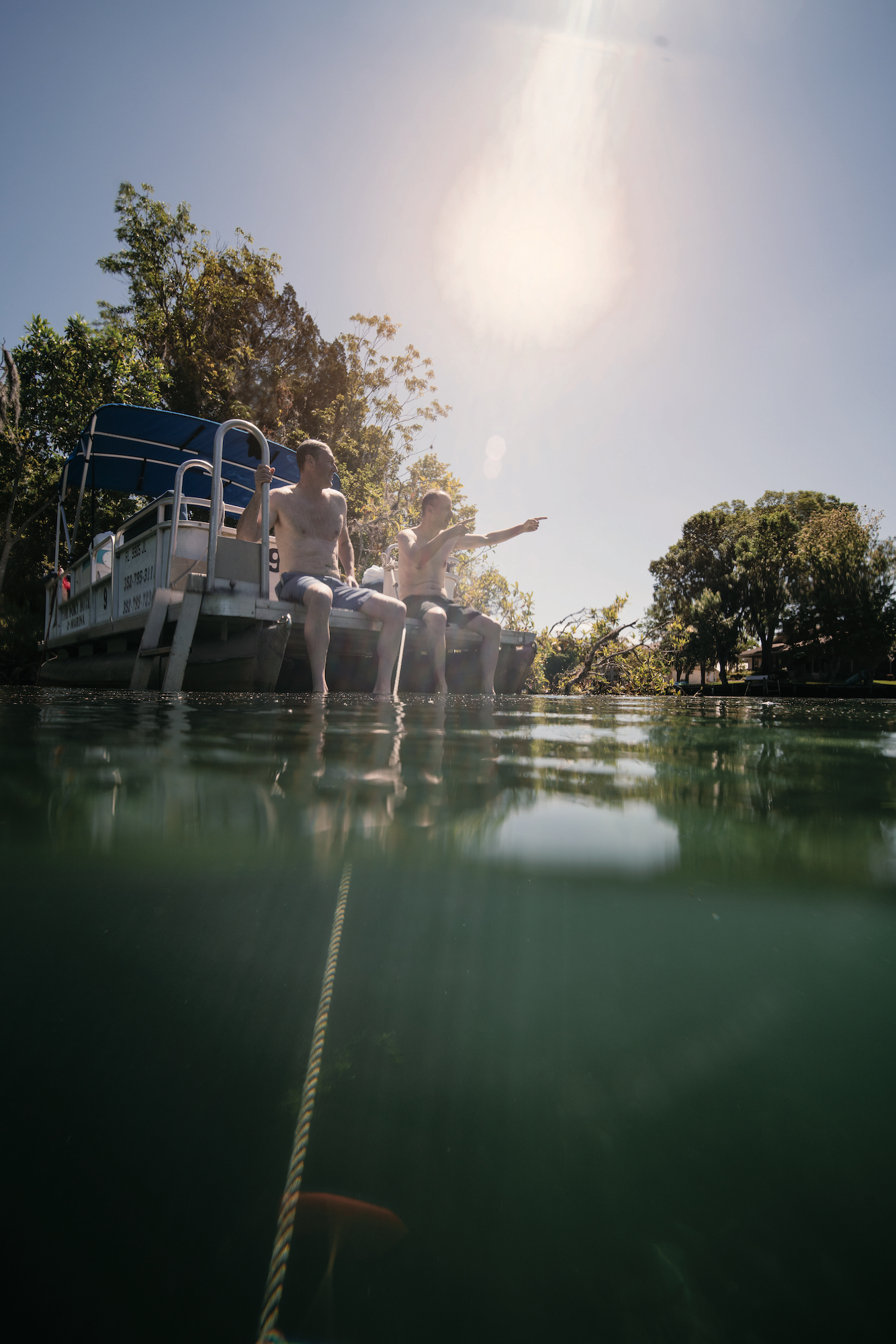
Photo: Cavin Brothers
Perched on a pontoon boat.
We drive through stands of thin scrubby pines, branches like old toothbrush bristles, and tidal marsh as smooth as a golf green. Hitting the coast, we pass bright pink- and peach-colored McMansions, packed so tightly that we can only infer that the Atlantic lies somewhere on the other side of them. In an otherwise ordinary-seeming beach town, we circle what appears to be a full, multi-turreted medieval castle without finding any apparent entrance or explanation for its existence. Here is Florida! Gussie’s and ours: unfathomable, unpredictable, and ungovernable. Everyplace and no place. Seeming to simultaneously contain all of America and to exist in some extraterritorial space beyond the levees of American life. Home to hustlers, exiles, dreamers, losers, and, of course, that most beloved and reviled manifestation of the national id: Florida Man.
That night, in St. Augustine, we sit at a bar and eat Minorcan clam chowder and the first of what I hope will be many fish sandwiches. We stroll through narrow cobblestoned streets, past gift shops and pirate-themed bars, feeling the great pleasure, as Gussie puts it, of walking “without direction, to walk as a fellow at loose ends with no greater goal than to unwind the clock until curfew.”
Later we sit on the balcony of our U-shaped motel, drinking Calvados out of paper cups and watching heat lightning flash over the Atlantic. Here and there fellow guests also sit outside in twos and threes, talking softly, opening cans from coolers, playing music that drifts lightly across the parking lot. I think of a scene from Ivory Shoals in which Gussie passes by a series of ruined and hastily abandoned manors, their owners fled north for what was left of Confederate army protection:
They’d lost what they’d lost. Gussie had lost what he’d lost. Others had had nothing to lose to begin with. None of it was fair or unfair. They just had to keep going. Everyone. They had to keep going toward whatever was there.
For the record, the first leg of our trip would be the last time I would sit in the driver’s seat for the next three days. Ostensibly, the reason for John’s unilateral takeover of the steering wheel is that I am needed to navigate with my iPhone. John has never owned a smartphone, preferring instead old-fashioned flip phones that, from the look of them, he must source from something like Albanian eBay. He also refuses to communicate by text message and is completely absent from social media. This amounts to excellent marketing in these over-sharing times. Product differentiation. He and I average one two-hour conversation per year, and I always remember it.
We met twelve years ago, at a dinner party in Oxford, Mississippi. I was visiting from New York, where I then lived, to attend my first SEC football game. He had just arrived with his wife, Heather, to spend a year as the John and Renée Grisham Writer in Residence at the University of Mississippi, an honor that included living in a rambling, somewhat mildewy house across the street from William Faulkner’s old home.
John looked then more or less as he does now: tall, rangy, and all-American, with the wardrobe and cowlicks of a kid on his way to summer camp. He and Heather were at the end of a six-year period during which they had moved every three months, a lifestyle sustained by her ability to work short stints anywhere as an occupational therapist. They headed north in the summer and south in the winter. At each stop, John would find some kind of manual labor, often with the ephemeral odds and ends of American culture. In Oregon, it was working at a lumber mill that produced the wooden shafts of arrows used in middle school archery; in Albuquerque, a paper company that made fast-food bags; in Virginia Beach, he assembled diploma frames. The idea was to leave a day’s work with creative resources all but untouched. He would nap and then write, always longhand and usually standing up, to accommodate a chronically bad back, using the top of a dresser as a desk.
All this peripatetic work surely contributed to the wide-ranging, clear-eyed empathy that defines John’s writing. His books are populated by so-called “ordinary” men and women, many of them adrift on the margins of modern America, often in circumstances they imagine, sometimes correctly, to be beneath their inner talents. His characters regularly confront the boundaries of what they are capable of, sometimes heroically, as with Gussie, but more often in darker ways. Arkansas was a neo-noirish, sporadically violent tale of small-bore drug dealers in over their heads that was really about the search for surrogate family. Its follow-up, Citrus County, which landed a rave on the cover of the New York Times Book Review, features one of the tenderest, funniest depictions of teen love you’ll find, except for the minor detail that one of the kids involved has kidnapped the younger sister of the other and is keeping her in an underground bunker. In addition to Gussie’s, Ivory Shoals slips seamlessly into the heads of the hero’s dissolute half brother, feverishly making his way home from San Francisco to intercept him, of the morally ambivalent caretaker of their father’s estate, and of the hard-bitten hunter on Gussie’s trail, among others.
John is the least writerly writer I have ever met.
He exhibits none of the self-regard, the performative neurosis, or the vanity in suffering nearly always found in the literary species. Neither is he some kind of self-consciously rough-hewn primitive. He simply does his work, steadily and matter-of-factly. To be honest, it is a little annoying.
“It’s like he birthed his relationship to writing all by himself,” says Eli Horowitz, who edited John’s first three novels, and a collection of short stories for Mc- Sweeney’s. “I don’t think anybody really wanted him to be a writer. I don’t know that he necessarily wanted that for himself. So, he pursues it in totally his own way.”
Padgett Powell, the venerable novelist with whom John studied at the University of Florida, and whom he considers a mentor, remembers him as a student primarily for having a crew cut and saying almost nothing in class.
“He showed no signs of disturbance. He showed no signs of being full of shit. There wasn’t anything particularly promising about him,” Powell says. “But to write the stuff he’s written, he’s got to be disturbed and full of shit. He’s just not dysfunctionally full of shit, and he’s not disturbed to the point of dysfunction.”

Photo: Cavin Brothers
Sunset in Tarpon Springs.
There are three main routes that spindle their way across the map southwest from St. Augustine toward Gainesville. We choose the center line at random and quickly leave the breezes of the coast behind, heading into the great sunbaked, fish-sandwich-less middle of the peninsula. We pass rows of cabbage and sugarcane, pastures in which heavy, black-hided cows graze beneath myrtles and palm trees, white ibis pecking the ground at their hooves, each element seemingly assembled from wildly different landscapes.
Coming out of Palatka, we round a bend and what do we see but a distinct bowl carved out of the topography at the foot of an old cemetery.
Sinkhole!
We pull into the parking lot of the attached crematorium and stroll down the length of the graveyard to gaze over the lip of the depression. It gazes back, unmistakably a hole. The sinkhole in Ivory Shoals is the hideout of a sinister outlaw named Thomas Pons who poses a late and deadly obstacle to Gussie’s progress. John made up the name, entirely from his imagination. And yet, walking back up to the car, I am brought up suddenly short by one of the graves. I call John over and point at the headstone: It reads JOYCE K. PONS. We stare at it solemnly, wondering if perhaps this journey has more purpose than we imagined.
Without further divine coincidence, we reach Gainesville. We meander across the pastoral campus of the University of Florida. John arrived here as an undergraduate, not entirely aware that “writer” was a job one could aspire to. He grew up in New Port Richey, about forty miles north of Tampa. John’s father was a gifted electrical engineer who worked at power plants before retiring; his mother managed an insurance office. Neither was especially book-minded. “By the fifth or sixth grade, I had gotten all I was going to get at home in that regard,” John says. Instead, he turned to the literary curators at the local mall branch of Waldenbooks, from which he shoplifted entire authors’ catalogues, diligently liberating volumes of Hemingway and Kerouac, occasionally a wild card like Nietzsche or Jeanette Winterson, in the waistband of his teenage shorts.
For all that, he was ready by the time he took his first writing class: “They didn’t have to show me a Flannery O’Connor short story twice,” he says. “I was like, ‘Okay. I see what this is. This is what I want to do.’”
We head toward Steve Spurrier-Florida Field at Ben Hill Griffin Stadium, the awkward official name of what everybody calls the Swamp. With the possible exceptions of his family and the short stories of Joy Williams, Florida football is the only passion of which I’ve ever heard John speak. He follows the Gators with a kind of grim obsession that I would not quite call pleasure. When they lose, he once told me, he takes it less as a defeat and more a referendum on his place in the universe: “It makes me think I’m a bad person,” he said.
Surprisingly, we are able to walk right in, and through to the stands. A few hardy souls run up and down the steps between rows of empty bleachers in the bright sunlight. An enormous sign lists the years of Florida’s SEC championships, including the two in the 1990s that overlapped with John’s time on campus. “Those were the Roman Colosseum days,” he says, looking around. “When Tennessee would come down, nobody on the student side would ever sit down, just screaming for Peyton Manning’s blood.”
It is only on the principle that one doesn’t wear a band’s T-shirt to the same band’s concert that he has not worn any Florida-branded clothing on this trip. He says that every other piece of his clothing fits neatly into his small suitcase. Which is Gators orange.
Like any epic, Gussie Dwyer’s journey involves a necessary passage through a Dark Wood—in his case, the boggy wilderness he enters in hopes of evading the hunter on his trail. In John’s telling, it is a boiling primordial stew of hostility to human life: “The spiders heavy as kittens. Alligators, patient as the seasons and without scruple. A foulness of air Gussie knew he could not imagine. The very sump of the world.”
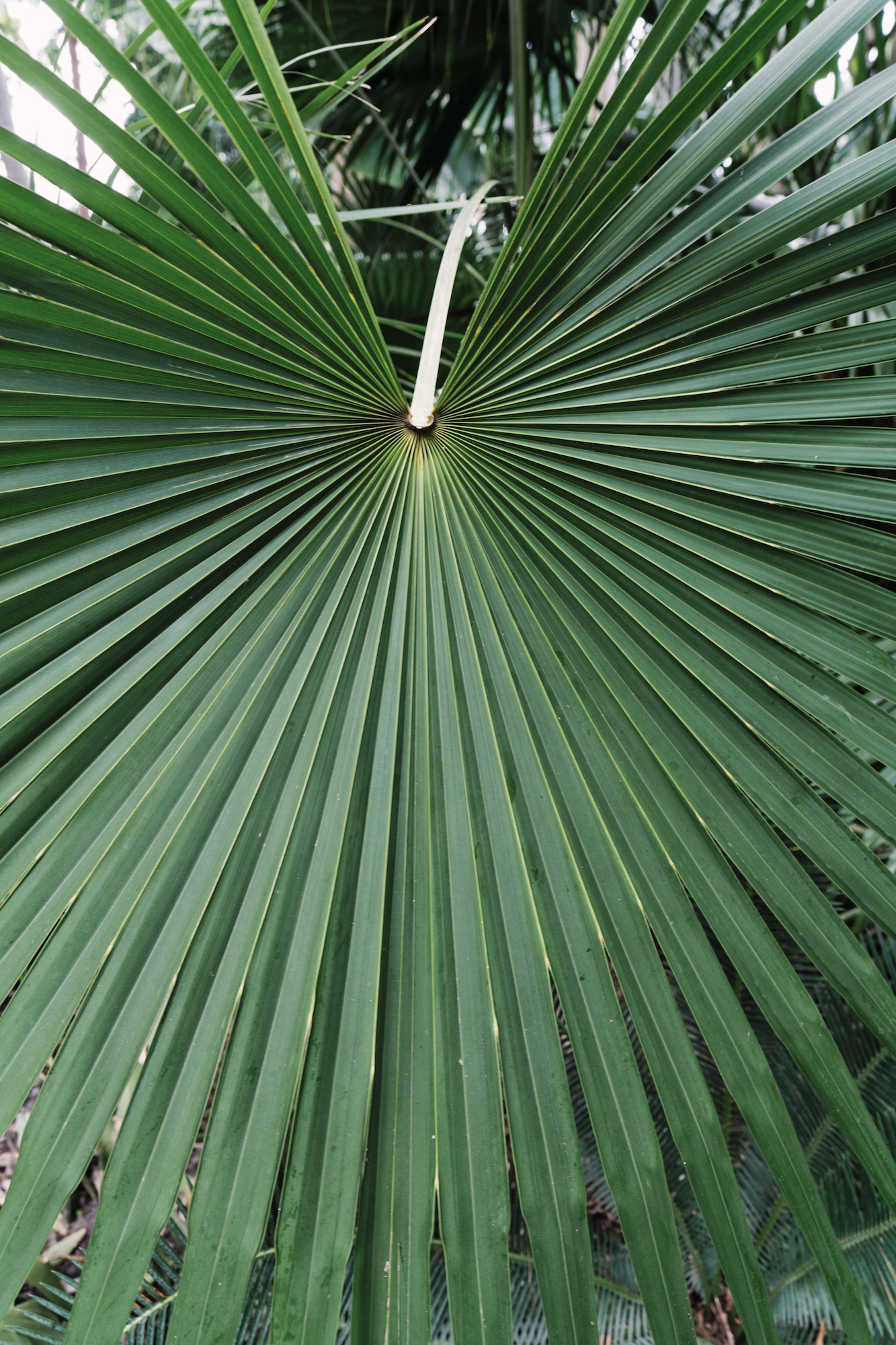
Photo: Cavin Brothers
Florida flora.
This is not to mention the mosquitoes. The list is reminiscent of the increasingly dire warning signs we encounter as we head into Paynes Prairie Preserve, a nearly 23,000-acre state park just south of Gainesville that boasts herds of wild bison and horses, and profuse alligators among its dangers. Above all, Gussie contends with blinding thirst. So it seems appropriate that we somehow conspire to arrive at Paynes Prairie without any water ourselves. (Related, I have a tip for anybody looking to open a convenience store in an area with no competition.)
“Let the record show that, for authenticity’s sake, we set out without provisions,” John says as we press on to La Chua Trail. It winds a short way through woods before leading to a boardwalk over an expanse of water hyacinth—an undulating green carpet marked here and there with what look like discarded designer handbags. They are not handbags, but rather the backs of lurking alligators, poking up through the greenery. Just how much more of the beasts lies beneath is driven home when we see a gator at least seven feet long out of the water and motionless on a grassy hill. We take turns assuring each other that it is definitely dead until the monster suddenly labors to its feet and lumbers off toward a nearby pond. It is far away and moving in the opposite direction, but the fear is nevertheless inescapable: deep and primitive.
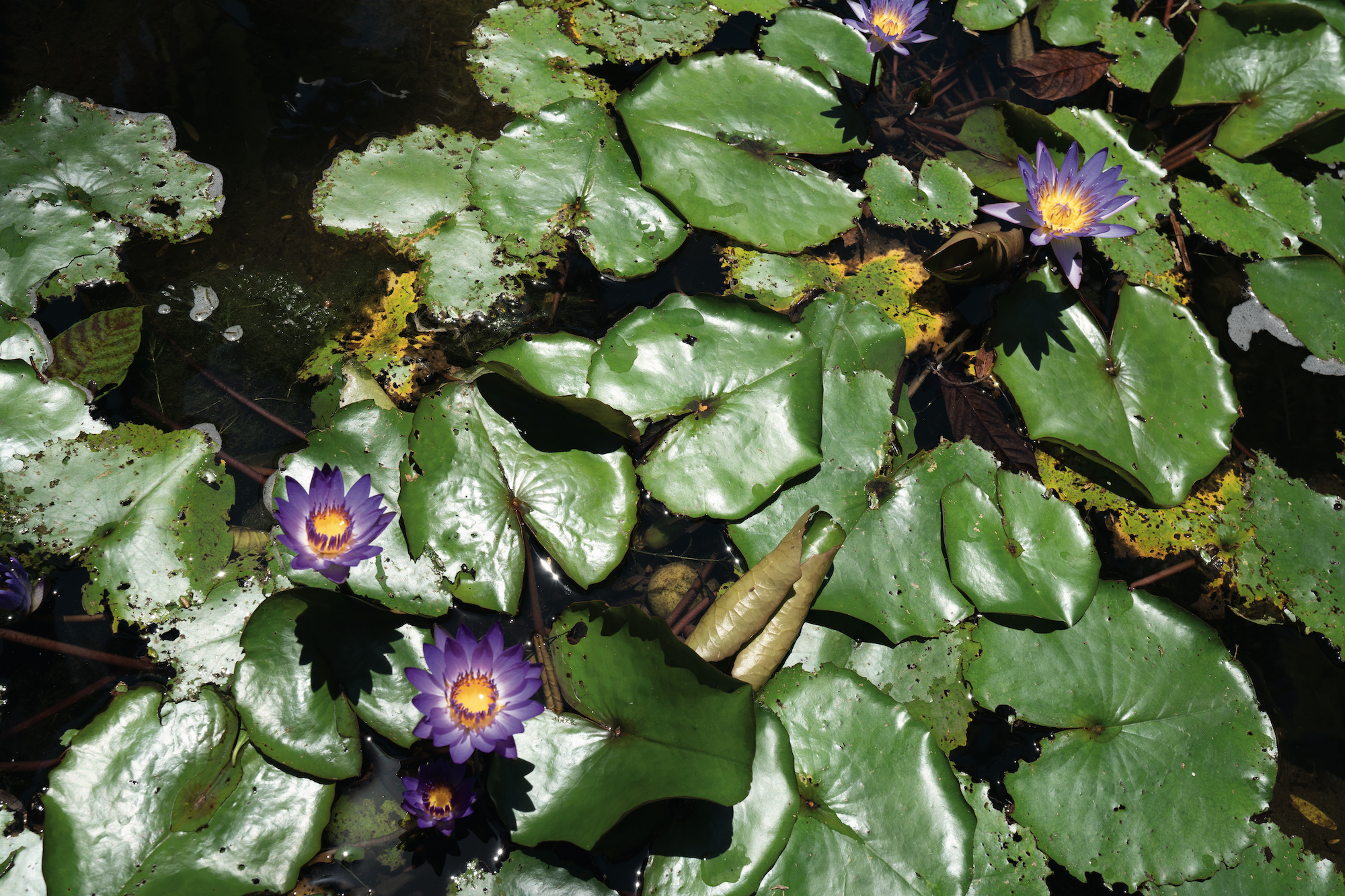
Photo: Cavin Brothers
Water lilies.
This too is the Florida that John grew up in and aimed to capture in Ivory Shoals: a natural world of intermingled beauty and savagery. A mere thirty-minute walk from civilization we come out onto the shore of a long, muddy pond and what feels like the Land of the Lost. Dozens of alligators circle the water as though in the moat of the castle we saw long ago at the coast. Great blue herons glide across the sky like pterodactyls. We watch an osprey swoop down to pluck out a fish as easily as picking up keys off a table. Two black vultures sit watching in the branches of a dead tree.
We both start in momentary panic when a cormorant suddenly bursts out of the brush as we pass. It goes flapping awkwardly into the river with a splash, one wing jutting out at an odd angle. Our brief alarm is followed by guilt over sending it into the water, where it is a sitting duck, almost literally, for the alligators.
We are each too polite to ask the other whether he more fervently fears or hopes to see it happen.
The Gulf of Mexico announces itself in the distance with luminous blue skies, engorged white cumulus clouds, and the cooling towers of the Crystal River Nuclear Plant, which appear on the horizon like twin milk bottles as we pass into Citrus County. Our destination is Crystal River and the springs that feed it, creating an ideal and protected winter home for manatees.

Photo: Cavin Brothers
Manatees at Crystal River.
We rent a pontoon boat and putter out among the many snorkel-tour boats. This feels like the anti–Paynes Prairie: the one place in this part of Florida where nothing is trying to bite, sting, or eat you. It is an Eden, or at least as close as you can get amid pods of tourists floating on brightly colored pool noodles, butts in the air and faces submerged, in search of manatees.
At the entrance to Three Sisters Springs, we drop anchor and don snorkels ourselves. We push through the cold green water, watching stripes of sunlight pulsate across waving seagrass like LEDs. Suddenly my vision is filled by two blob-like fields of color. One is silver gray and the other a smaller greenish brown. Having passed countless representations of manatees over the past several days—on billboards, restaurant signs, license plates; standing on their tails holding mailboxes—it is startling to see this mother and calf in the flesh. The baby circles its mother, emitting high-pitched chirps. They resemble, in the cutest way possible, waterlogged garbage bags. I hang as motionless as I can, letting the water’s movement rock me to and fro, instructing myself to in effect be a manatee. It is surprisingly soothing.
Like Gussie, whose anxiety about meeting his father makes him slow down as he nears his goal, John and I now find ourselves dawdling, as if to postpone the inevitable return to our regular lives. We weave in and out from the coast, following the call of curious place names: Yankeetown, where eight workers sit drowsily beneath a COVID-19 vaccination tent in the town square; its appropriate neighbor, Historic Crackertown, named, John says, for the cattle-rustling frontiersmen of early Florida who were called Crackers after the sound of their bullwhips in action. In Homosassa, we drink beer overlooking Monkey Island, where a group of spider monkeys allegedly makes its home. We see a tiny lighthouse, assorted climbing apparatuses, but no simians. Perhaps, like the rest of America, they’ve had enough of staying home.
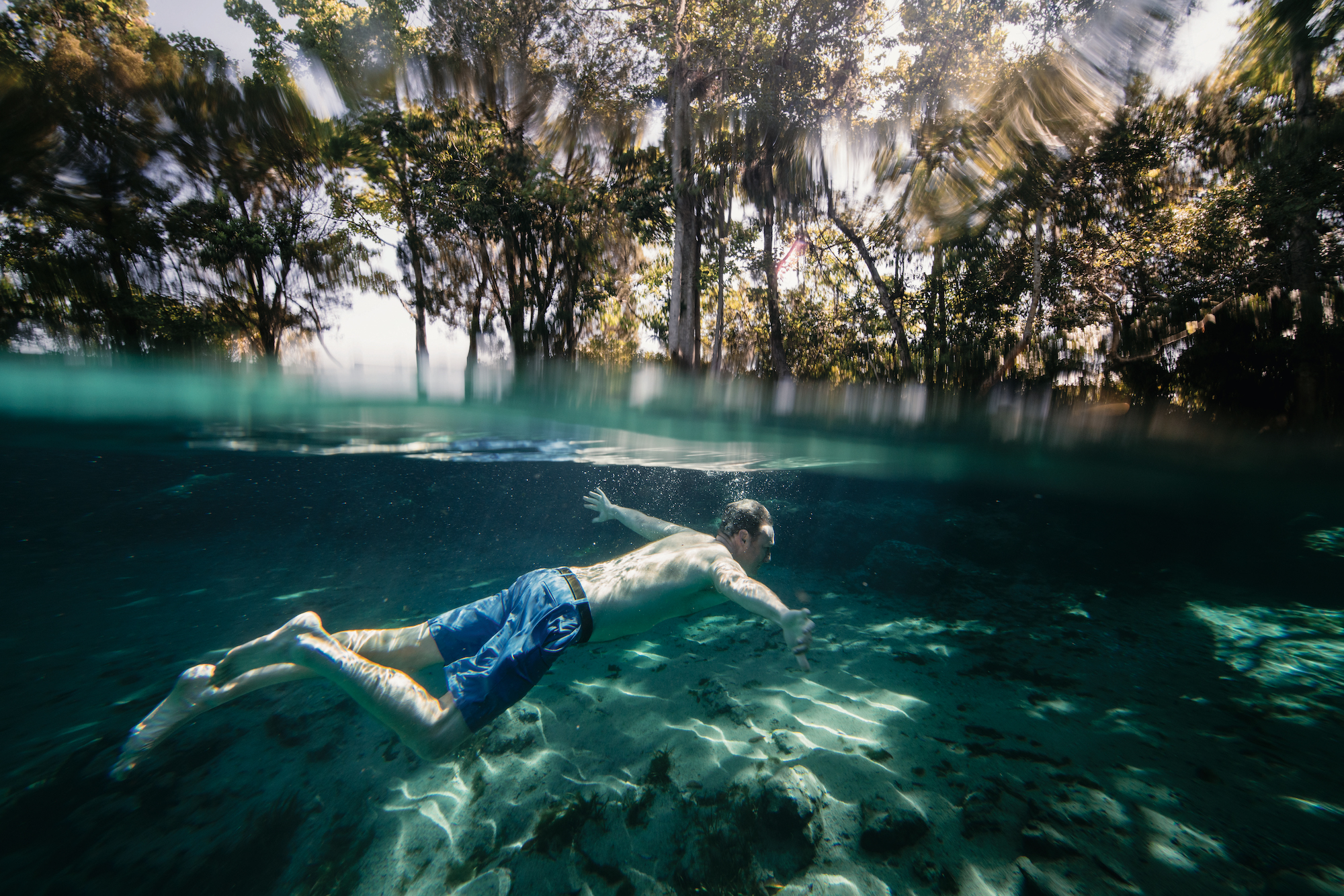
Photo: Cavin Brothers
Taking a dip at Three Sisters Springs.
Heading out of Homosassa, we pull over to examine the ruins of a sugar mill once owned by David Yulee, the notorious railroad and sugar baron, pro-slavery activist, and one of the first two U.S. senators from Florida. We park by a picnic shelter where an old man in a blue baseball cap sits, and make our way around the collapsing stone walls and rusting machinery. As we walk back to the car, the man in the cap detaches himself from his bench and walks toward us. He’s short and wiry, with a face as hard and gnarled as a cypress knee and the stub of a brown cigarette between his fingers.
“You see the face?” he says.
John and I look at each other. We shake our heads.
“The face up there.” The man points with his cigarette hand to the top of the mill’s ruined stone chimney. “You see that white stone?”
We squint up at one stone near the top that stands out as lighter than the rest. From a distance it seems pockmarked, but it’s hard to make out anything resembling a face.
“I guess so…” John says, accommodatingly.
The man smiles in satisfaction. “I’ve been seeing that face since I was in the second grade,” he says. “They took us here on a field trip. It was covered in vines then. All those other stones turn gray, but that one never does. A woman the other day, she asked me who cleaned that one stone. I told her: Nobody does.”
“Wow” is all we can think to say. The man nods.
“Nobody,” he repeats, gravely.
We head to the car, and by the time we pull off, he has retaken his spot in the shade, waiting for the next person to happen by to whom he can reveal his own private miracle.
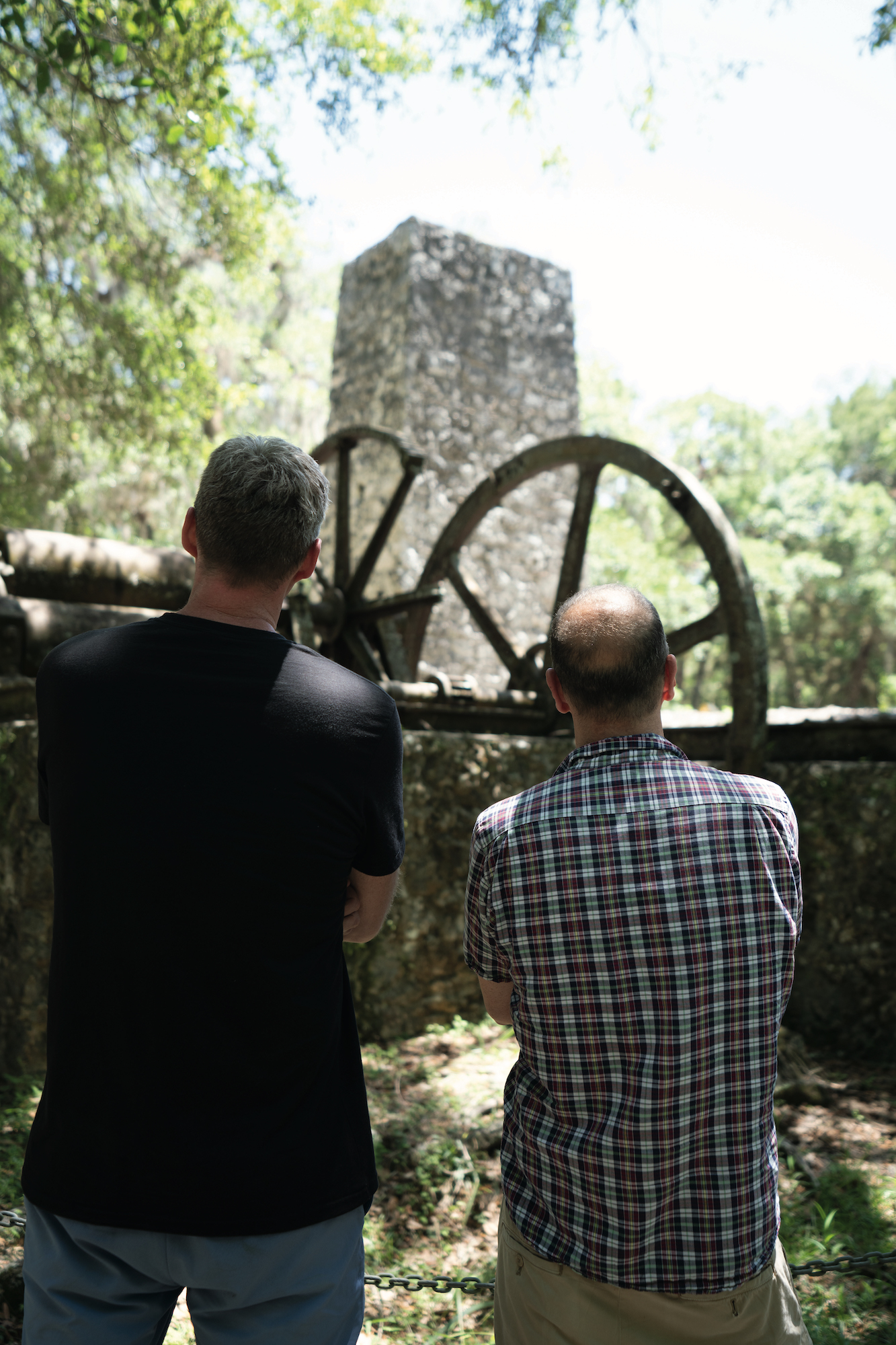
Photo: Cavin Brothers
Sugar mill ruins outside Homosassa.

Photo: Cavin Brothers
Communing with a local.
And now we join Route 19, winding south past Weeki Wachee, home to the famous underwater mermaid show; Hernando Beach; and Bayonet Point. We pass ice cream stands shaped like colorful ice cream cones. An enormous pink dinosaur. Strip malls filled with Bible stores and nail salons and sorry-looking strip clubs. We pull off and cross the Pithlachascotee River into New Port Richey, John’s hometown. There’s a pretty park and a bunch of newish civic architecture that makes the downtown look a bit like a minor-league baseball stadium. We follow a road along the river, lined with lovely houses with flower beds and boat docks, and eventually turn down Lakeview Drive.
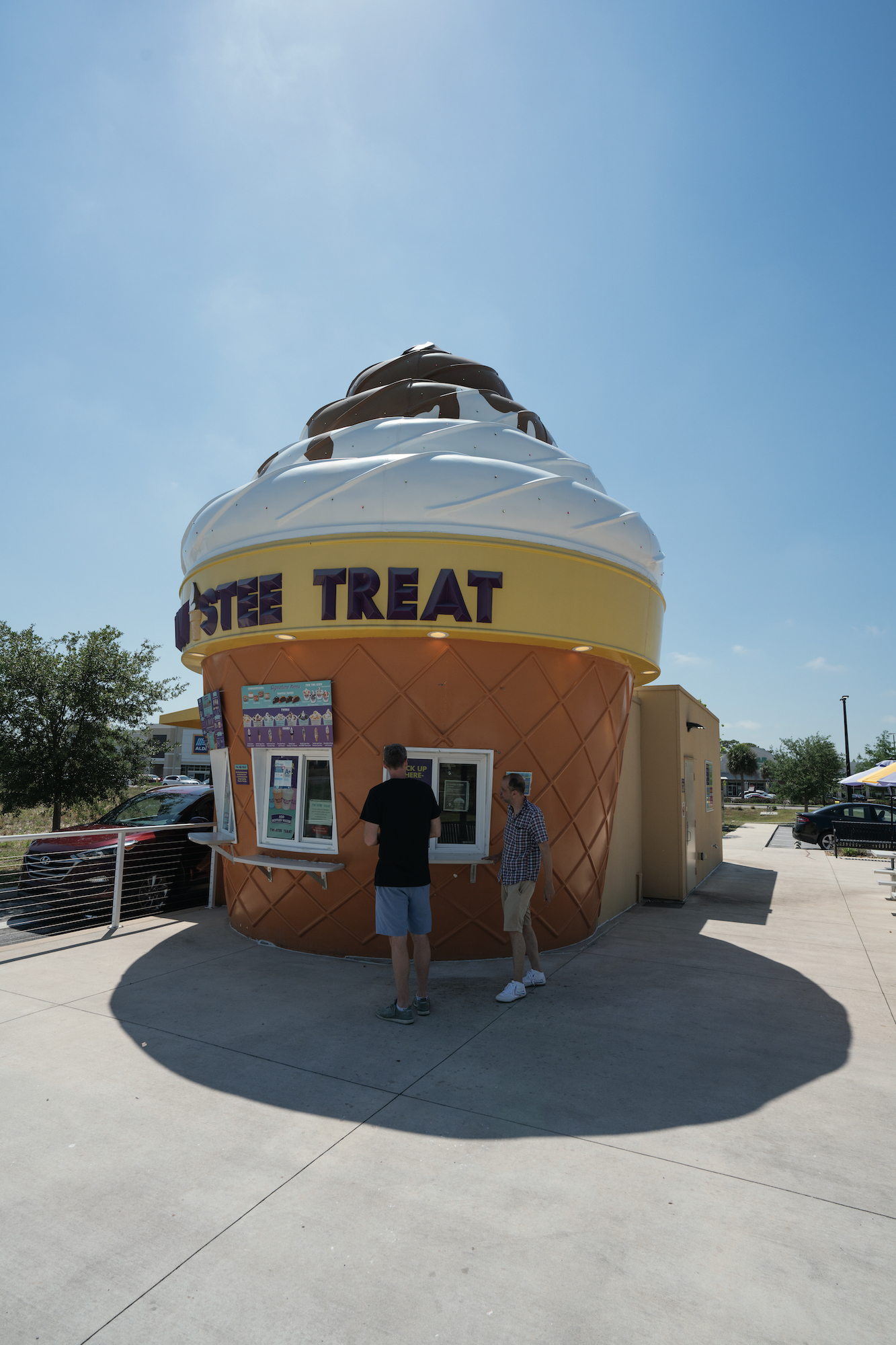
Photo: Cavin Brothers
Ice cream at the Twistee Treat on Route 19.

Photo: Cavin Brothers
Roadside color.
“There is no lake,” John says, dryly.
John’s parents still live nearby, but it’s been years since he visited the house he grew up in. So much development has happened in that time that finding the street now is easier said than done. We tour a succession of cul-de-sacs, each with three or four houses surrounding a circular drive and a basketball hoop, as if it grows there. At one point, we turn a bend and John slams the brakes. “What the f**k?” he says. We’ve come right up on a tall black fence; the woods he wandered for untold hours as a kid are now a gated community. Finally, we find it: a low-slung gray ranch house with solar panels on the roof and a TRUMP-PENCE sign in an upper window.
“What did a kid do growing up in New Port Richey?” I ask as we drive back toward Route 19.
“Wander around and smoke cigarettes, try to get beer, and then go to Denny’s,” John says. “We finally resorted to doing acid, which was a good thing to shape your weekend around.”
You don’t really strike me as the psychedelic type, I say.
“I don’t strike anybody as any type,” he says. It’s the first time, maybe ever, that I have heard a trace of irritation in his voice. “I don’t have a personality.”
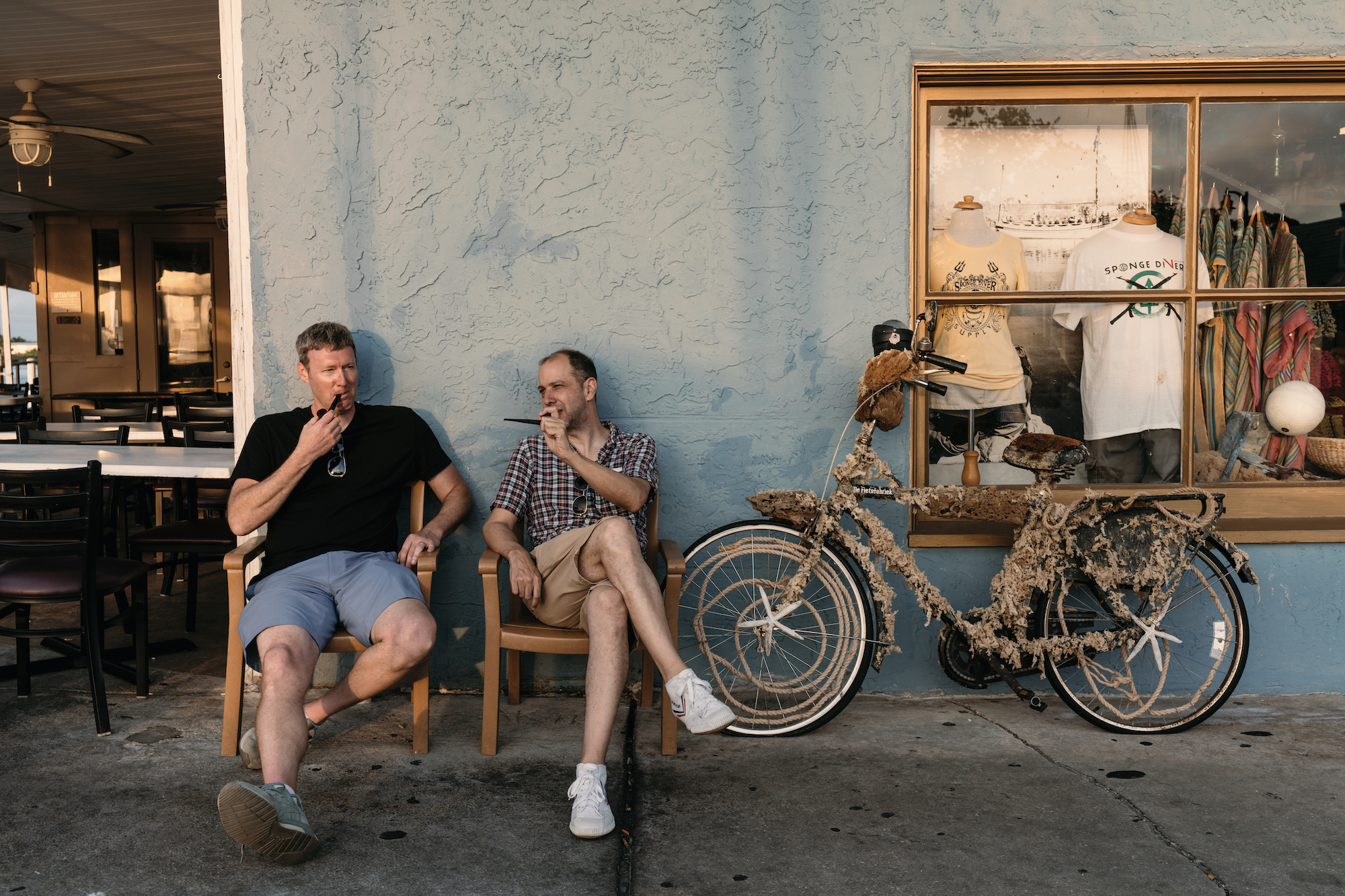
Photo: Cavin Brothers
Taking a break in Tarpon Springs.
We continue south mostly in silence, listening to a baseball game on the radio. The sun is angling low across the sponge-fishing docks of Tarpon Springs by the time we pull into town. The boats that have recently come in from their long offshore expeditions hold huge, bulbous mountains of sponges, held down by nets as though they are in danger of floating away like balloons. Those getting ready to head out have their tiny galleys stacked with canned food for the long nights ahead. Every building seems to house either a gift shop or a Greek restaurant, so that the whole town is the blue and white of a diner’s takeout coffee cup. This is roughly where the fictional plantation called Ivory Shoals lay in John’s imagination, the place where Gussie Dwyer meets his destiny. We sit outside of a café, snacking on fried sardines, and lift a Greek beer to the end of his journey.
We, however, have just a little farther to go. When we reach St. Petersburg, we walk to the downtown marina and find a bench under an oak tree. The sun is going down, glinting off of hundreds of brilliant sailboats and yachts. As Gussie did, we feel the breadth of the peninsula at our backs: “There it sat. Humanity as wicked as one could conceive, or as worthy. Country both perilous and splendid. Showers and storms and the punishing surveillance of the sun.”
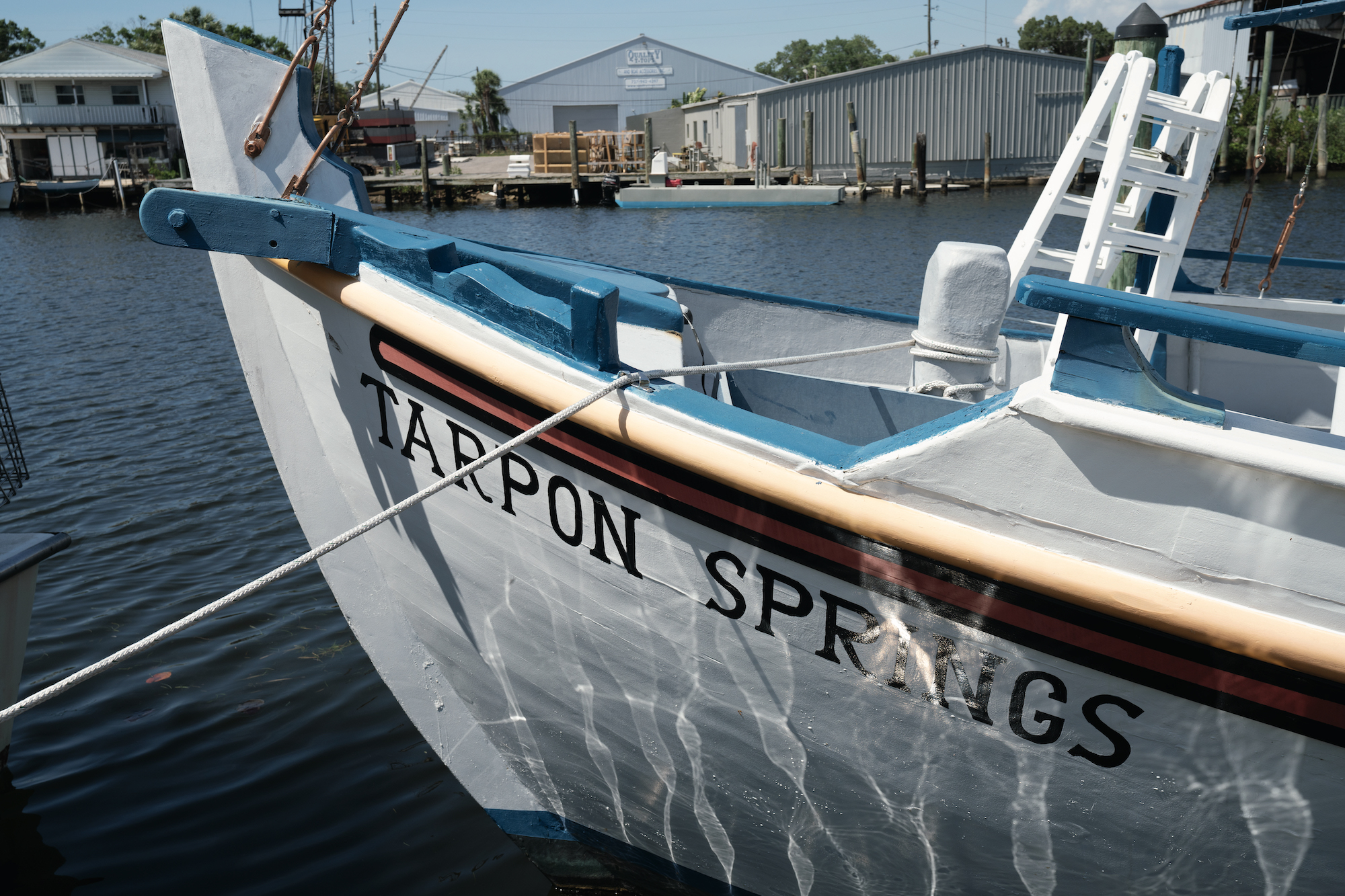
Photo: Cavin Brothers
A spongefishing boat.
There’s only one thing left to do. John digs the pipes and tobacco out of his bag. We pack the pipes, then take turns unsuccessfully trying to light them in the mild breeze, as passing joggers and cyclists shoot us glares. Eventually, the matches run out. So we just sit there quietly, looking out over the cool, still blue water.


